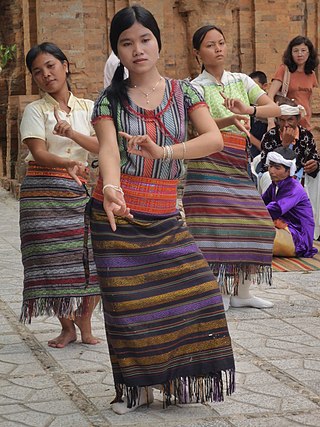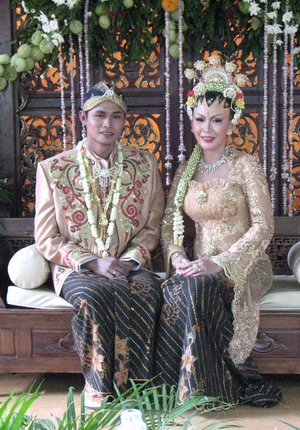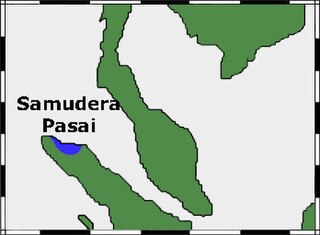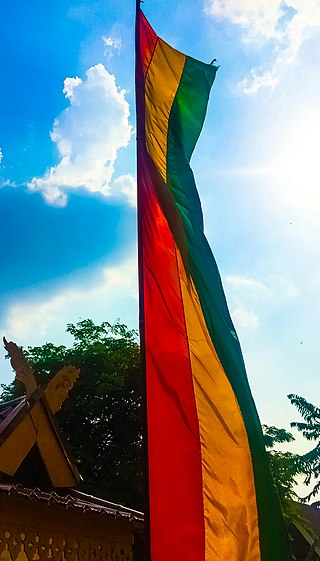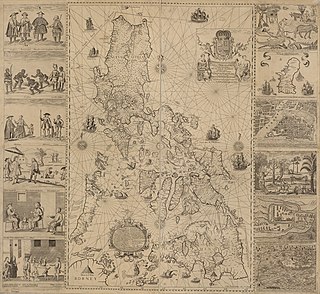History
Origins
Muslim merchants dominated trade in Southeast Asia by the 9th century or earlier. [11] There existed a colony of foreign Muslims on the west coast of Sumatra by 674 AD; other Muslim settlements began to appear after 878 AD when Islam increasingly took root among the people. However, little remains from these early communities, and the religion did not spread to significant parts of the population until the 12th century.
In 2017, a group of Japanese archaeologists, while working on a tenth-century CE shipwreck in Quang Ngai, Champa of which is now Vietnam, discovered ceramic shards with inscriptions in Indic script refer to a place near what is now Hormuz, Iran. Inscriptions on some fragments end with a pentagram or a hexagram, which led Islamic historian Do Truong Giang to interpret it as the Seal of Solomon. [12]
According to Edward H. Schafer, there are several passages in Chinese chronicles compiled during the Five Dynasties and Ten Kingdoms period (907–979 CE) mention some Islamic activities in the Champa Kingdom during the 10th century CE. The Chinese described that "the customs of the Chams are identical as those of the Arabs (Dashi or Tajik)," and "the Cham king, whenever he goes out, he wears a large shirt of Arab brocade or Sichuan brocade." [13] An excerpt recorded in the Song Huiyao Jigao notes the practice of dhabīḥah among the Chams:
[In Champa] There are also mountain cattles, but they cannot be used for ploughing. They are only killed in sacrifice to the spirits. When they are about to be slaughtered, a medium is instructed to offer prayers, which sound thus: Allahu Akbar. In translation, this means: "May he be early reborn." [13]

Muslim traders along the main trade-route between Western Asia and the Far East are thought to have been responsible for the introduction of Islam to Southeast and East Asia. The religion was then further spread by Sufi orders and finally consolidated by the expansion of the territories of converted rulers and their communities. [14] The first Muslim communities arose in Aceh in Northern Sumatra. Malacca was an early stronghold of Islam as well, and it served as a starting point from which Islam was propagated along the trade routes in the region. [14] There is no clear indication of when Islam first came to the region, but the first Muslim inscriptions have been dated to 1028 was found in Pahang, Malaysia. An Arabic pillar inscription dating between 1029 to 1035 was discovered in Champa, modern-day Vietnam, followed by an Arabic gravestone of Abu Ibrahim dating 1039, also found in Champa. Then an Arabic engraving from Brunei dated to 1048, marking the tomb of a Muslim woman. In East Java, a 1082 tombstone of a Muslim woman named Fatimah binti Maimun was also discovered. [15]
When Marco Polo visited the area in 1292 he noted that the urban port state of Perlak was Muslim, [16] Chinese sources record the presence of a Muslim delegation to the emperor from the Kingdom of Samudra (Pasai) in 1282, [14] other accounts provide instances of Muslim communities present in the Melayu Kingdom for the same time period while others record the presence of Muslim Chinese traders from provinces such as Fujian. [16] The spread of Islam generally followed the trade routes east through the primarily Buddhist region and a half century later in the Malacca's we see the first dynasty arise in the form of the Sultanate of Malacca at the far end of the Archipelago form by the conversion of one Parameswara Dewa Shah into a Muslim and the adoption of the name Muhammad Iskandar Shah after his marriage to a daughter of the ruler of Pasai. [14] [16] In 1380, Sufi orders carried Islam from here on to Mindanao. [17]
Another driving force for the change of the ruling class in the region was the concept among the increasing Muslim communities of the region when ruling dynasties to attempt to forge such ties of kinship by marriage.[ citation needed ] By the time the colonial powers and their missionaries arrived in the 17th century the region up to New Guinea was overwhelmingly Muslim with animist minorities. [16]
The first written sources of Islam in Southeast Asia in 916 AD came from a merchant describing his experience in 1851 on the Island of Sumatra. [10] Over time a series of Muslim port villages emerged on the scarcely populated coast. [10] Islamic teachers from these port villages ventured to the interior of Sumatra. [10] Over time these ports attracted Muslims from India, China, and the Arabian peninsula. [10] These communities surpassed their utilitarian functions for trade and were integrated into the global network of Islam. [10] Islam was popular in Southeast Asia because it, unlike previous belief systems could be used to validate a ruler's power through the divine. [5] The introduction of Islam throughout Southeast Asia and the Indonesian archipelago was an uneven, gradual and relatively pacific process that was heavily influenced by trade and interactions with merchants and sufi missionaries. [18] [19]
In the 12th century, the Indian Chola navy crossed the ocean and attacked the Srivijaya kingdom of Sangrama Vijayatunga Varman in Kadaram (Kedah). The capital of the powerful maritime kingdom was sacked and the king was taken captive. Along with Kadaram, Pannai in present-day Sumatra and Malaiyur and the Malayan peninsula were attacked. Soon after, the King of Kedah Phra Ong Mahawangsa became the first ruler to abandon the traditional Hindu faith and converted to Islam with the Sultanate of Kedah established in year 1136. Samudera Pasai converted to Islam in the year 1267. In the early 15th century, the first Sultan of Malacca, Parameswara, married the princess of Pasai, and their son converted to Islam. [20] Soon Malacca became the centre of Islamic study and maritime trade; other rulers followed suit.
Islamic expansion in Southeast Asia
By the end of the 15th century, several areas of northern Sumatra, including what is now Java, were governed by Muslim rulers. [10] It wasn't until 1641 that the first Sultan took their title in what is now Java. [10] Islam initially arrived on the coast of Sumatra, and spread down and around the coast to the Malacca strait and jumped across the strait to the Malay Peninsula. [9]
In 1511, the Portuguese took over Malacca, but various other Muslim states began to grow in size and economic and political prominence. For example, Aceh dominated the region, both politically and economically, in the early seventeenth century. Through familial and trade relationships in these Muslim states, non-Islam states were slowly exposed to the faith. As it spread, Islam encountered pre-existing spiritual beliefs [21] — including Buddhism and Hinduism [22] — which continued to be practiced alongside Islam or were incorporated into Islam. Indeed, the faith introduced by some of the religious merchants was Sufism, a mystical version of Islam that is rejected by more conservative Muslims. [23] Islamic law was also formally practiced in most areas that had encountered Islam, affecting cultural practices. [21]

There are several theories and factors that have been proposed to explain the Islamisation process of Southeast Asia. The first is trade. The expansion of trade among West Asia, India and Southeast Asia helped the spread of the religion as Muslim traders brought Islam to the region. Muslim merchants from various regions in India and West Asia played a pivotal role in establishing Islam in Southeast Asia. [24] [25] A second theory is the role of the Sufis. The Sufi missionaries played a significant role in spreading the faith by syncretising Islamic ideas with existing local beliefs and religious notions. [24] Thirdly, the ruling classes embraced Islam which further aided the permeation of the religion throughout the region. The ruler of the region's most important port, Malacca Sultanate, embraced Islam in the 15th century, heralding a period of accelerated conversion of Islam throughout the region as the religion provided a unifying force among the ruling and trading classes. The word daulat refers to the legitimacy of a ruler, through the power of God, and suggests the strong relationship between rule, legitimacy, and the spread of Islam. [26] A less influential factor for Islamisation was due to conquest. [18] While mostly done for economic and territorial expansion, conquests could of led to eventual conversions after the establishment of a Islamized kingdom, which often deployed missionaries and created religious infrastructure to aid in converting the newly acquired populations. [27]
The spread of Islam to Southeast Asia also depended largely on the translation and availability of religious texts. This was largely through Malay, a language that transected class. [22] There are also a number of works in Javanese, particularly related to Javanese-Islamic mysticism. [28] Some of the most significant Malay authors that helped in this translation are Hamzah Fansuri, Shams al-Din, and 'Abd al-Ra-uf. [21]



